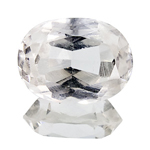Anglesite
Quite common sulfate mineral.

Due to it's low hardness and perfect cleavage, anglesite is only very rarely cut as a gemstone and not suitable for use in jewellery.
Origin of name: according to the English Wikipedia entry, William Withering, an English scientist, discovered the mineral in the Parys coppermine on the island of Anglesey in Wales and recognized it as a mineral species in 1783.
The German Wikipedia entry states that Antoine Grimoald Monet, a French mine-inspector general, described the newly discovered mineral as "vitriol de plombe", lead sulfate, as early as 1779.
It's final name anglesite was coined by François Sulpice Beudant (1787–1850), a French mineralogist and physicist, in 1832.
Synonyms and trade names: none for gem Anglesite.
Often called lead sulphate or lead vitriol by miners.
Can be confused with: due to the very high refractive index, which lies outside the range of standard refractometers, identification of cut and polished anglesite can be tricky. The extremely high density (specific garvity) is no big help either, because there a number of minerals with similar physical properties, such as cerussite, scheelite, wulfenite and cassiterite.
Localities: so far (2013) more than 2500 occurrences are known. Facettable anglesite comes from Touissit (Marocco), the Bunker Hill Mine in Idaho (USA) and Tsumeb (Namibia).
Handling: anglesite is sensitive to heat, acids and pressure, scratches easily and thus is unsuitable for jewellery use.
Due to it's high lead content and it's solubility in acid, anglesite must be regarded as potentially hazardous to health. Do not grind dry, do not inhale anglesite dust and wash hands after handling!
Worth knowing: despite it's high lead content of up to 69% (74% according to some sources), anglesite has only regional importance as an iron ore. Anglesite mostly occurs as individual crystals in lead-bearing lodes, which mostly contain galena and other lead minerals. Only very rarely, e.g. in Mexico and Australia, anglesite occurs in masses large enough to be mined as a lead ore.
 Deutsch
Deutsch